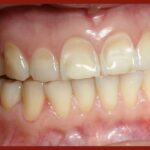
Dental erosion is the irreversible loss of tooth tissue by chemical processes not involving bacteria. The early signs are a smooth glazed or silky appearance of the teeth with scooping or cupping of the occlusal surfaces. The prevalence of dental erosion in children has been estimated to Be 39.64% (95% CI: 27.62% to 51.65%) (Li Y. et al 2022) and is considered to be increasing. Gastric juices have a greater potential than other extrinsic acids for causing enamel and dentine erosion and reviews indicate a prevalence of gastro-oesophageal reflux disease (GERD) in children ranging between 0 to 38% ( Yip K, et al 2022)
The aim of this review was to evaluate the association between gastro-oesophageal reflux disease (GERD) and dental erosion in children
Methods
Searches were conducted in the Cochrane Library, Embase, Medline, Trip Pro, Web of Science and the international Clinical Trials Registry Platform and ClinicaTrials.gov databases with Open Grey, Proquest Dissertations and Thesis and Google Scholar being used to search for grey literature. Two reviewers independently screened and selected studies and extracted data. Study quality was evaluates using the Strengthening the Reporting of Observational studies in Epidemiology (STROBE) guidelines and the Newcastle-Ottawa Scale (NOS) .
Randomised controlled trials (RCTs), cohort studies, cross-sectional surveys and case-control studies evaluating the association between GERD and dental erosion in children (1-18 years, with no limitations on the language or year of publication were considered. The primary outcome was the proportion of children identified to have dental erosion in enamel in at least one tooth. Secondary outcomes included the proportion of children with dental erosion into dentine, proportion of teeth with enamel erosion and the proportion of teeth with dentine erosion. Odds ratios (OR) and 95% confidence intervals (CIs) were calculated, and random effects meta-analysis conducted.
Results
- 13 studies (7 cross-sectional, 6 cohorts) were included.
- Patients ages ranged from 1.5 to 18 years.
- 5 studies examined primary and permanent teeth, Two studies all primary teeth and 6 studies permanent teeth only.
- GERD was defined using 8 different criteria
- 2 studies were considered to be at low risk of bias on the NOS the remainder at moderate risk.
- The proportion of children with GERD with enamel erosion ranged from 11-96% [12 studies].
- The pooled OR for erosion of
- enamel associated with GERD = was 4.46 (95%CI; 1.93 to 10.30) [12 studies].
- dentine erosion associated with GERD = 39 (95%CI; 4.17 to 42.94) [3 studies].
- enamel associated with GERD (tooth as unit) = 3.29 (95%CI; 1.36 to 7.95) [3 studies].
- dentine associated with GERD (tooth as unit) = 5.91(95%CI; 2.35 to 14.86) [3 studies].
Conclusions
The authors concluded: –
The present work identifies a positive association between GERD and dental erosion in children. The heterogeneity in the definition of GERD across studies should be considered when interpreting the present findings. In future studies, paediatric GERD should be defined according to a universal guideline. A uniform definition should improve the usefulness of studies in advancing clinical practice and enhancing children care.
Comments
The authors have undertaken and extensive search of the literature resulting in the inclusion of 13 studies. The findings do suggest a positive association between GERD and dental erosion in children. However, GERD is just one risk factor for dental erosion and a number of other dietary factors (Dental Elf – 19th Jun 2020) and eating disorders (Dental Elf – 2nd Nov 2015) are also linked. As highlighted by the authors the findings need to be interpreted cautiously because of the wide variation in the diagnostic methods used for GERD in the included studies with the 13 studies using 8 different sets of criteria. In future the use of an agreed international diagnostic criteria for GERD would assist future studies. Future studies should also take into consideration other confounding factors such as dietary factors.
Links
Primary Paper
Li Y, Wang Z, Fang M, Tay FR, Chen X. Association between gastro-oesophageal reflux disease and dental erosion in children: A systematic review and meta-analysis. J Dent. 2022 Oct;125:104247. doi: 10.1016/j.jdent.2022.104247. Epub 2022 Jul 30. PMID: 35917996.
Other references
Yip K, Lam PPY, Yiu CKY. Prevalence and Associated Factors of Erosive Tooth Wear among Preschool Children-A Systematic Review and Meta-Analysis. Healthcare (Basel). 2022 Mar 7;10(3):491. doi: 10.3390/healthcare10030491. PMID: 35326969; PMCID: PMC8953165.
Singendonk M, Goudswaard E, Langendam M, van Wijk M, van Etten-Jamaludin F, Benninga M, Tabbers M. Prevalence of Gastroesophageal Reflux Disease Symptoms in Infants and Children: A Systematic Review. J Pediatr Gastroenterol Nutr. 2019 Jun;68(6):811-817. doi: 10.1097/MPG.0000000000002280. PMID: 31124988.
Dental Elf – 19th Jun 2020
Dental Elf – 2nd Nov 2015
Picture credits
, CC BY-SA 3.0
